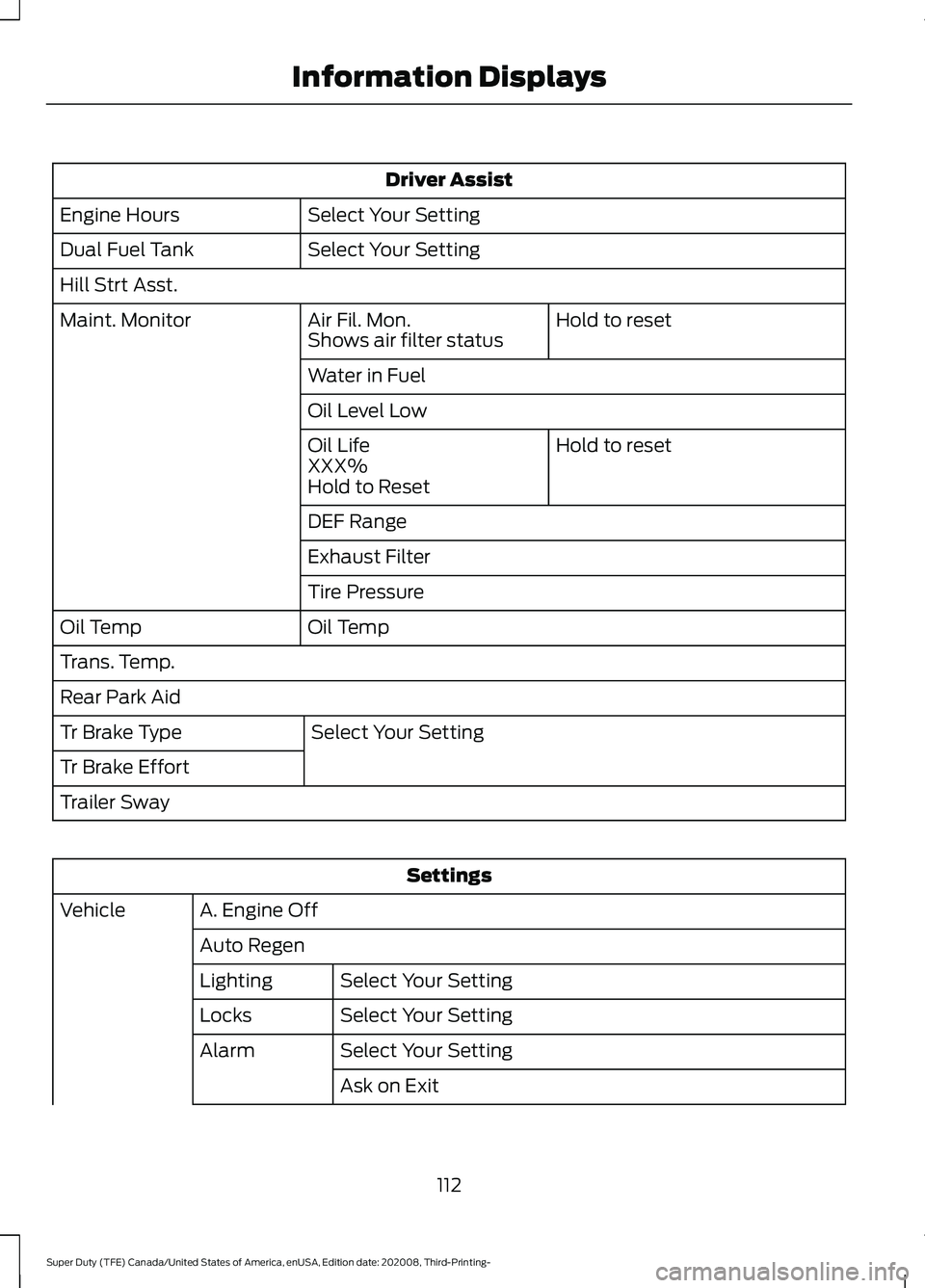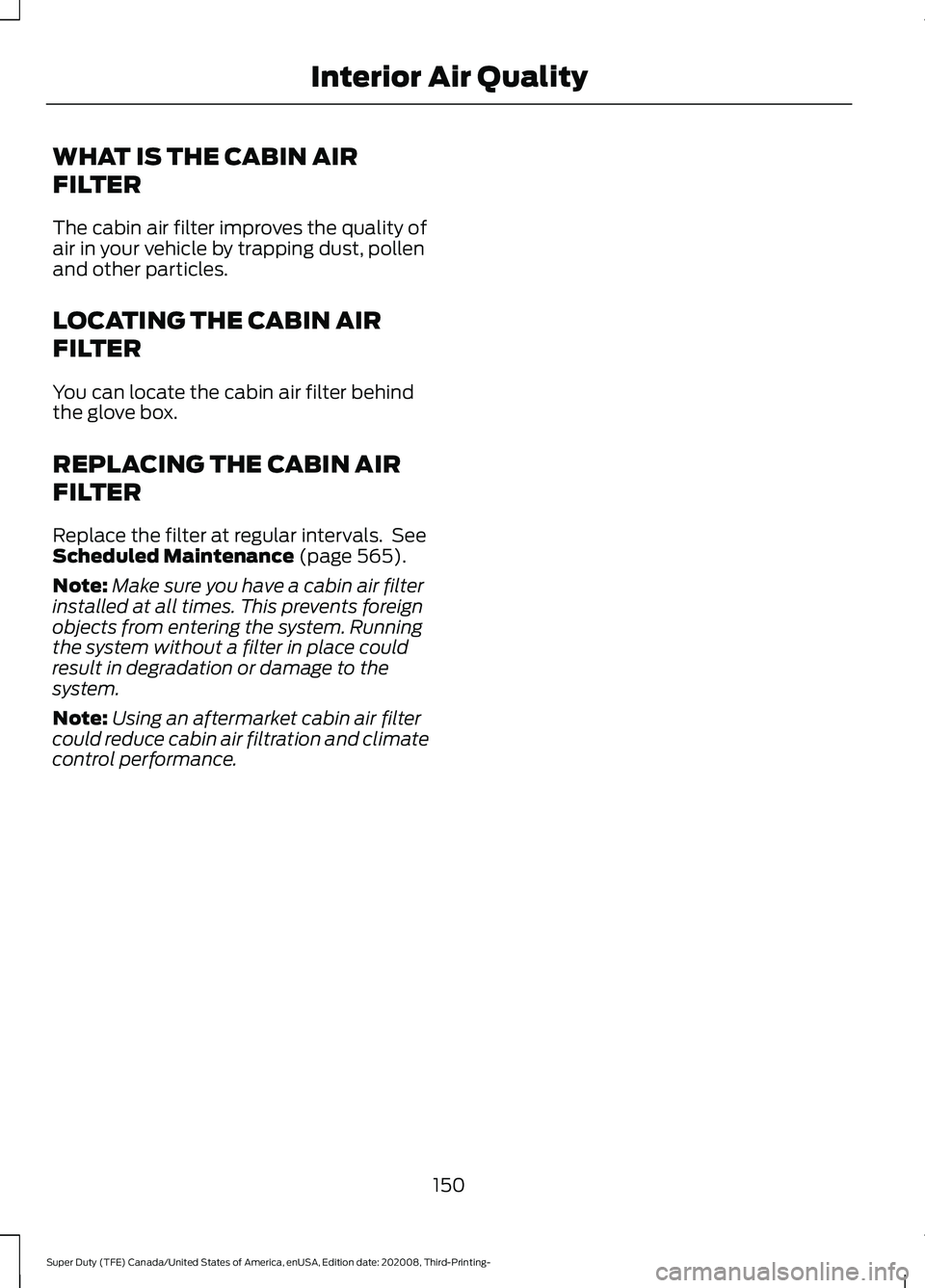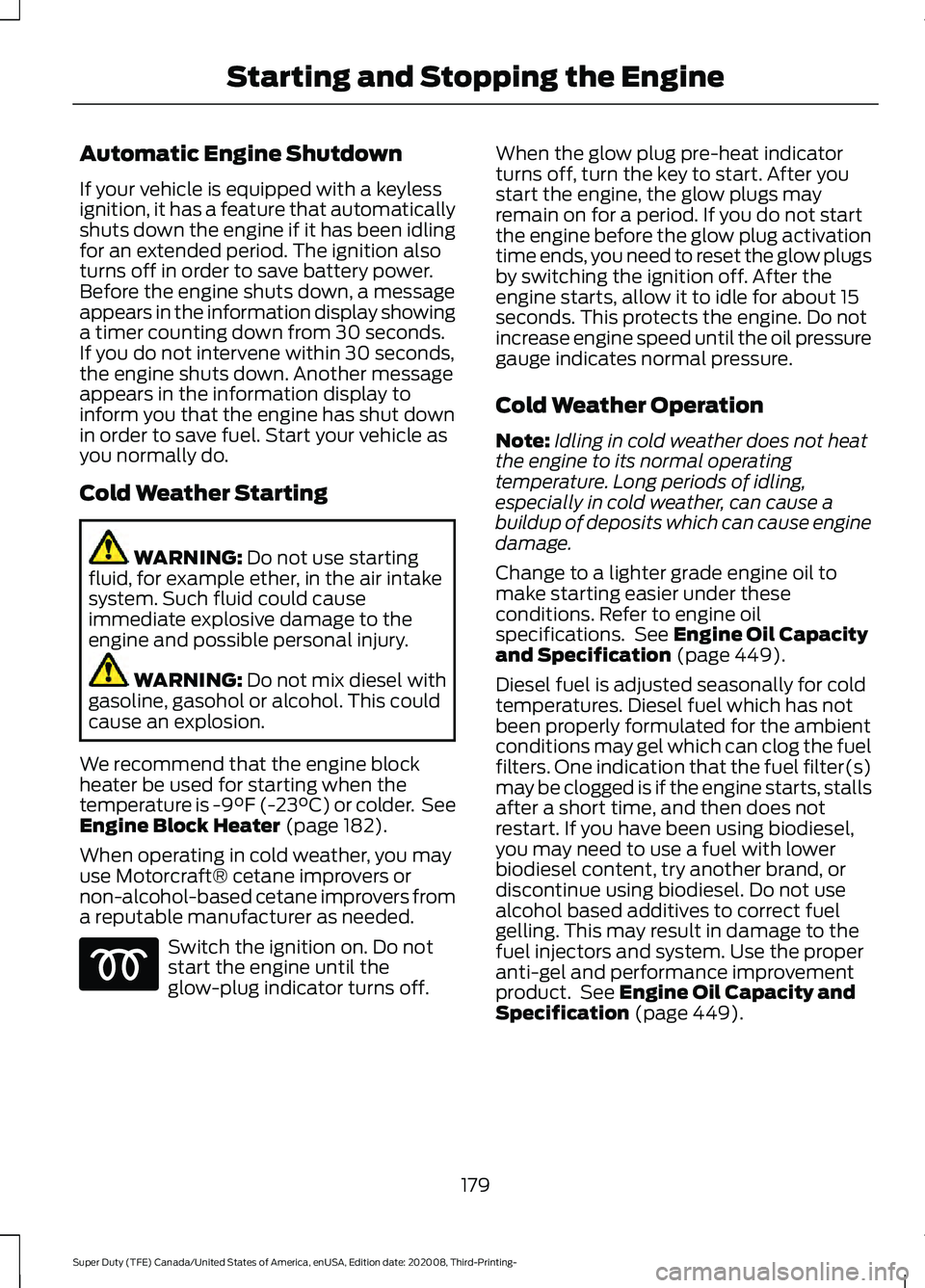2021 FORD F-550 air filter
[x] Cancel search: air filterPage 6 of 666

Climate Control - Vehicles
With: Automatic
Temperature Control
Identifying the Climate Control Unit .....143
Switching Climate Control On and Off ........................................................................\
.
143
Switching Recirculated Air On and Off ........................................................................\
.
143
Switching Air Conditioning On and Off ........................................................................\
.
143
Switching Maximum Defrost On and Off ........................................................................\
.
143
Switching Maximum Cooling On and Off ........................................................................\
.
143
Switching the Heated Wiper Park On and Off .................................................................
144
Switching the Heated Rear Window On and Off ........................................................
144
Switching the Heated Mirrors On and Off ........................................................................\
.
144
Setting the Blower Motor Speed ...........
144
Setting the Temperature ..........................
144
Directing the Flow of Air ............................
145
Auto Mode ......................................................
145
Climate Control – Troubleshooting ......
146
Climate Control - Vehicles With: Manual Temperature
Control
Identifying the Climate Control Unit ......
147
Switching Climate Control On and Off ........................................................................\
.
147
Switching Recirculated Air On and Off ........................................................................\
.
147
Switching Air Conditioning On and Off ........................................................................\
.
147
Switching Maximum Defrost On and Off ........................................................................\
.
147
Switching Maximum Cooling On and Off ........................................................................\
.
147
Switching the Heated Rear Window On and Off ........................................................
148Switching the Heated Mirrors On and Off
........................................................................\
.
148
Setting the Blower Motor Speed ...........
148
Setting the Temperature ..........................
148
Directing the Flow of Air ...........................
148
Climate Control – Troubleshooting ......
149
Interior Air Quality
What Is the Cabin Air Filter ......................
150
Locating the Cabin Air Filter ....................
150
Replacing the Cabin Air Filter .................
150
Seats
Sitting in the Correct Position ..................
151
Head Restraints .............................................
151
Manual Seats ................................................
153
Power Seats ..................................................
154
Memory Function .........................................
157
Rear Seats ......................................................
158
Heated Seats ................................................
160
Ventilated Seats ............................................
161
Rear Occupant Alert System
What is the Rear Occupant Alert System ........................................................................\
.
162
How Does the Rear Occupant Alert System Work .............................................
162
Rear Occupant Alert System Precautions ........................................................................\
.
162
Rear Occupant Alert System Limitations ........................................................................\
.
162
Switching Rear Occupant Alert System On and Off - Vehicles With: SYNC
........................................................................\
.
162
Switching Rear Occupant Alert System On and Off .................................................
163
Rear Occupant Alert System Indicators - Vehicles With: SYNC 3 ........................
163
Rear Occupant Alert System Indicators - Vehicles With: SYNC ...........................
163
3
Super Duty (TFE) Canada/United States of America, enUSA, Edition date: 202008, Third-Printing- Table of Contents
Page 9 of 666

Getting Assistance Outside the U.S. and
Canada .......................................................335
Ordering Additional Owner's Literature ........................................................................\
337
Reporting Safety Defects (U.S. Only) ........................................................................\
337
Reporting Safety Defects (Canada Only) ........................................................................\
337
Fuses
Fuse Specification Chart .........................
339
Changing a Fuse .........................................
346
Maintenance
General Information ..................................
348
Opening and Closing the Hood .............
348
Under Hood Overview - 6.2L .................
349
Under Hood Overview - 6.7L Diesel .....
350
Under Hood Overview - 7.3L ....................
351
Engine Oil Dipstick - 6.2L .........................
352
Engine Oil Dipstick - 6.7L Diesel ............
352
Engine Oil Dipstick - 7.3L ..........................
352
Engine Oil Check - 6.2L .............................
352
Engine Oil Check - 6.7L Diesel ...............
354
Engine Oil Check - 7.3L .............................
355
Changing the Engine Oil and Oil Filter ........................................................................\
356
Oil Change Indicator Reset .....................
356
Changing the Engine Air Filter - 6.2L ........................................................................\
357
Changing the Engine Air Filter - 6.7L Diesel ..........................................................
358
Changing the Engine Air Filter - 7.3L ....
360
Draining the Fuel Filter Water Trap - 6.7L Diesel ...........................................................
361
Engine Coolant Check - 6.2L .................
364
Engine Coolant Check - 6.7L Diesel .....
368
Engine Coolant Check - 7.3L ....................
371
Automatic Transmission Fluid Check ........................................................................\
376
Transfer Case Fluid Check ........................
377Brake Fluid Check
........................................
377
Power Steering Fluid Check ....................
378
Changing the 12V Battery ........................
379
Adjusting the Headlamps ........................
381
Washer Fluid Check ...................................
382
Fuel Filter - 6.2L/7.3L .................................
382
Checking the Wiper Blades ....................
382
Changing the Wiper Blades ....................
382
Changing a Bulb ..........................................
383
Changing the Engine-Mounted and Diesel Fuel Conditioner Module Fuel
Filters - 6.7L Diesel .................................
386
Spring U-Bolt Check - F-600 ................
389
Vehicle Care
General Information ...................................
391
Cleaning Products .......................................
391
Cleaning the Exterior .................................
392
Waxing ............................................................
393
Cleaning the Engine ...................................
393
Cleaning the Exhaust - 6.7L Diesel ......
394
Cleaning the Windows and Wiper Blades ........................................................................\
394
Cleaning the Interior ..................................
395
Cleaning the Instrument Panel and Instrument Cluster Lens .......................
397
Cleaning Leather Seats ............................
397
Repairing Minor Paint Damage .............
399
Cleaning the Wheels .................................
399
Vehicle Storage ...........................................
399
Wheels and Tires
General Information ..................................
402
Tire Care ........................................................
404
Using Snow Chains ....................................
420
Tire Pressure Monitoring System ...........
421
Changing a Road Wheel ..........................
429
Technical Specifications .........................
440
6
Super Duty (TFE) Canada/United States of America, enUSA, Edition date: 202008, Third-Printing- Table of Contents
Page 13 of 666

Brake system
Cabin air filter
Check fuel cap
Child safety door lock or unlock
Child seat lower anchor
Child seat tether anchor
Cruise control
Do not open when hot
Engine air filter
Engine coolant
Engine coolant temperature
Engine oil
Explosive gas
Fan warning
Fasten seatbelt Flammable
Front airbag
Front fog lamps
Fuel pump reset
Fuse compartment
Hazard flashers
Heated rear window
Windshield defrosting system
Interior luggage compartment
release
Jack
Keep out of reach of children
Lighting control
Low tire pressure warning
Maintain correct fluid level
Note operating instructions
10
Super Duty (TFE) Canada/United States of America, enUSA, Edition date: 202008, Third-Printing- IntroductionE270480 E139223 E141128 E71340 E71880 E231160 E67017 E161353
Page 112 of 666

During refueling, it is possible for
you to pump
water-contaminated diesel fuel
into your fuel tank. Your vehicle ’s fuel
system is equipped with a fuel filter and
water separator to remove water from the
fuel. The water in fuel indicator illuminates
when the fuel and water separator has a
significant quantity of water in it and
requires immediate draining.
If the water in fuel indicator illuminates
when the engine is running, stop your
vehicle as soon as safely possible, shut off
the engine, then drain the fuel and water
separator. See Fuel Quality (page 187).
Allowing water to stay in the fuel system,
after the water in fuel indicator illuminates,
could result in extensive damage or failure
of the fuel injection system.
Note: Do not drain the fuel and water
separator while the engine is running. Air will
enter into the fuel system causing the engine
not to operate properly.
Four-Wheel Drive Indicators
(If
Equipped)
4X2 HIGH Illuminates momentarily when
two-wheel drive high is engaged.
4X4 HIGH Illuminates when four-wheel
drive high is engaged.
4X4 LOW Illuminates when four-wheel
drive low is engaged. AUDIBLE WARNINGS AND
INDICATORS
Key in Ignition Warning Chime
Sounds when you open the driver's door
and you have left the key in the ignition.
Keyless Warning Alert
(If Equipped)
Sounds the horn twice when you exit your
vehicle with the intelligent access key, after
the last door is closed and your keyless
vehicle is in RUN, indicating your vehicle is
still on.
Headlamps On Warning Chime
Sounds when you remove the key from the
ignition and open the driver's door and you
have left the headlamps or parking lamps
on.
Parking Brake On Warning Chime
Sounds when you have left the parking
brake on and drive your vehicle. If the
warning chime remains on after you have
released the parking brake, have the
system checked by an authorized dealer
immediately.
109
Super Duty (TFE) Canada/United States of America, enUSA, Edition date: 202008, Third-Printing- Instrument Cluster E181778 E181779 E181780
Page 115 of 666

Driver Assist
Select Your Setting
Engine Hours
Select Your Setting
Dual Fuel Tank
Hill Strt Asst.
Hold to reset
Air Fil. Mon.
Maint. Monitor
Shows air filter status
Water in Fuel
Oil Level Low
Hold to reset
Oil Life
XXX%
Hold to Reset
DEF Range
Exhaust Filter
Tire Pressure
Oil Temp
Oil Temp
Trans. Temp.
Rear Park Aid
Select Your Setting
Tr Brake Type
Tr Brake Effort
Trailer Sway Settings
A. Engine Off
Vehicle
Auto RegenSelect Your Setting
Lighting
Select Your Setting
Locks
Select Your Setting
Alarm
Ask on Exit
112
Super Duty (TFE) Canada/United States of America, enUSA, Edition date: 202008, Third-Printing- Information Displays
Page 153 of 666

WHAT IS THE CABIN AIR
FILTER
The cabin air filter improves the quality of
air in your vehicle by trapping dust, pollen
and other particles.
LOCATING THE CABIN AIR
FILTER
You can locate the cabin air filter behind
the glove box.
REPLACING THE CABIN AIR
FILTER
Replace the filter at regular intervals. See
Scheduled Maintenance (page 565).
Note: Make sure you have a cabin air filter
installed at all times. This prevents foreign
objects from entering the system. Running
the system without a filter in place could
result in degradation or damage to the
system.
Note: Using an aftermarket cabin air filter
could reduce cabin air filtration and climate
control performance.
150
Super Duty (TFE) Canada/United States of America, enUSA, Edition date: 202008, Third-Printing- Interior Air Quality
Page 182 of 666

Automatic Engine Shutdown
If your vehicle is equipped with a keyless
ignition, it has a feature that automatically
shuts down the engine if it has been idling
for an extended period. The ignition also
turns off in order to save battery power.
Before the engine shuts down, a message
appears in the information display showing
a timer counting down from 30 seconds.
If you do not intervene within 30 seconds,
the engine shuts down. Another message
appears in the information display to
inform you that the engine has shut down
in order to save fuel. Start your vehicle as
you normally do.
Cold Weather Starting
WARNING: Do not use starting
fluid, for example ether, in the air intake
system. Such fluid could cause
immediate explosive damage to the
engine and possible personal injury. WARNING:
Do not mix diesel with
gasoline, gasohol or alcohol. This could
cause an explosion.
We recommend that the engine block
heater be used for starting when the
temperature is -9°F (-23°C) or colder. See
Engine Block Heater
(page 182).
When operating in cold weather, you may
use Motorcraft® cetane improvers or
non-alcohol-based cetane improvers from
a reputable manufacturer as needed. Switch the ignition on. Do not
start the engine until the
glow-plug indicator turns off. When the glow plug pre-heat indicator
turns off, turn the key to start. After you
start the engine, the glow plugs may
remain on for a period. If you do not start
the engine before the glow plug activation
time ends, you need to reset the glow plugs
by switching the ignition off. After the
engine starts, allow it to idle for about 15
seconds. This protects the engine. Do not
increase engine speed until the oil pressure
gauge indicates normal pressure.
Cold Weather Operation
Note:
Idling in cold weather does not heat
the engine to its normal operating
temperature. Long periods of idling,
especially in cold weather, can cause a
buildup of deposits which can cause engine
damage.
Change to a lighter grade engine oil to
make starting easier under these
conditions. Refer to engine oil
specifications. See
Engine Oil Capacity
and Specification (page 449).
Diesel fuel is adjusted seasonally for cold
temperatures. Diesel fuel which has not
been properly formulated for the ambient
conditions may gel which can clog the fuel
filters. One indication that the fuel filter(s)
may be clogged is if the engine starts, stalls
after a short time, and then does not
restart. If you have been using biodiesel,
you may need to use a fuel with lower
biodiesel content, try another brand, or
discontinue using biodiesel. Do not use
alcohol based additives to correct fuel
gelling. This may result in damage to the
fuel injectors and system. Use the proper
anti-gel and performance improvement
product. See
Engine Oil Capacity and
Specification (page 449).
179
Super Duty (TFE) Canada/United States of America, enUSA, Edition date: 202008, Third-Printing- Starting and Stopping the Engine
Page 183 of 666

Your vehicle has a fuel and water separator
that recirculates fuel from the engine to
help prevent fuel filter clogging. To avoid
engine fuel starvation during cold weather
operation of 32°F (0°C) or below, we
recommend that the fuel level in your tank
should not drop below ¼ full. This helps
prevent air from entering the fuel system
and stalling the engine.
Your vehicle has a selective catalytic
reduction system that uses Diesel Exhaust
Fluid (DEF) to operate properly. You need
to replenish your vehicle ’s DEF at certain
intervals. When filling your vehicle ’s DEF
tank in cold weather, take special care to
prevent damage to the tank. See
Selective Catalytic Reductant System
(page
197).
In cold weather below
32°F (0°C), the
engine may slowly increase to a higher idle
speed if you leave it idling in park (P). As
the engine warms-up, the engine sound
level decreases due to the activation of
PCM-controlled sound reduction features.
If you operate your vehicle in a heavy
snowstorm or blowing snow conditions,
snow and ice can clog the engine air
induction. If this occurs, the engine may
experience a significant reduction in power
output. At the earliest opportunity, clear
all the snow and ice away from inside the
air filter assembly. Remove the air cleaner
cover and the air filter and remove any
snow or ice. Remove any debris, snow or
ice, on the foam filter by brushing the
surface with a soft brush. Once you have
cleared all of the debris, reinstall the air
filter and cover.
Do not use water, solvents, or a hard brush
for cleaning the foam filter. WARNING:
To reduce the risk of
vehicle damage and personal burn
injuries, do not start your engine with the
air cleaner removed and do not remove
it while the engine is running.
In order to operate the engine in
temperatures of 32°F (0°C) or lower, read
the following instructions:
• Make sure that the batteries are of
sufficient size and are fully charged.
Check other electrical components to
make sure they are in optimum
condition.
• Use the proper coolant solution at the
concentration recommended
protecting the engine against damage
from freezing.
• Try to keep the fuel tank full as much
as possible at the end of operation to
prevent condensation in the fuel
system.
• Make sure you use proper cold weather
engine oil and that it is at its proper
level. Also, if necessary, make sure to
follow the engine oil and filter change
schedule found under the Special
operating conditions section listed in
the scheduled maintenance
information.
• At temperatures of
-9°F (-23°C) or
below, it is recommended that you use
an engine block heater to improve cold
engine starting.
• If operating in arctic temperatures of
-20°F (-29°C)
or lower, consult your
truck dealer for information about
special cold weather equipment and
precautions.
180
Super Duty (TFE) Canada/United States of America, enUSA, Edition date: 202008, Third-Printing- Starting and Stopping the Engine